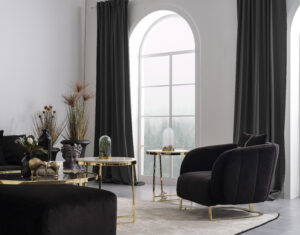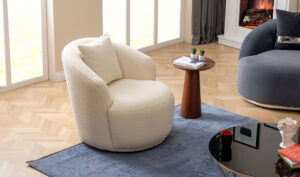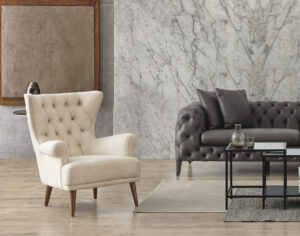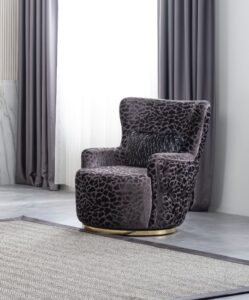Guide to Choosing the Perfect Armchair
The armchair is a simple design concept, yet it can be not easy to pick one for your home since they come in an array of styles and formats. While it can be overwhelming to pick out the right fit for you it is also an opportunity to express your taste and creativity.
Since armchairs come in so many different shapes and designs, you can have a lot of fun styling and personalizing them. When buying furniture such as sofas or dining tables, you must give a lot of consideration to the experience of other household members and guests. But when it comes to the singular-seated armchair, the aesthetic and function are completely up to you. Getting to choose how and where you want to style it is an opportunity to integrate self-expression into your space.
We all know the classic design of an armchair. A deep seat, high back with two armrests for maximum comfort. But within this scope, there is a lot of room for variety. Not all armchairs are designed for the same purpose. For example, the type of armchair you would choose for a family or cinema room is probably different from what you would choose for a reception space or hallway.
It can be hard to know where to start when you add to these considerations the vast range of fabric types, color schemes, comfort features, and additional furnishings, which is exactly why we have created this guide. Keep reading below to find a valuable set of tips to help you make the right choice.
Form and function
Armchairs can be used in rooms all over the house, from living spaces to bedrooms. The first decision you need to make relates to the overall style and purpose of the armchair. The designated destination for your chair can have a big impact on its style. For example, an armchair for your living room that has particular accents should match stylistically with other furniture. The style of the chair required will also depend on the purpose of your room, whether it’s a snug living space for cozying up, or a formal entertaining space for hosting guests.
For a relaxing space, think about deep seating areas, cushioned arms, and backs, with the possibility to really stretch out and sink back into the chair. For entertaining or conversational areas, your chair will need to contribute to your space both functionally and aesthetically. Here the chair is more about looking the part than being a receptacle for slouching in for an evening’s TV watching (although there are designs that cover both bases).
For a cozy corner to read books or just to relax, an armchair in the bedroom can serve a practical purpose. For reading, you probably want a chair that offers a greater degree of support with a higher and firmer back that is comfortable enough to sit in for hours. For armchairs placed in rooms like the entranceway or hallway, you may consider design over function. Since these spaces serve more practical purposes, like taking off shoes or chatting on the phone, this is a great opportunity to prioritize the artistic value of your armchair.
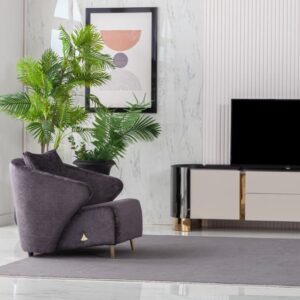
Weigh up the requirements in terms of comfort versus practicality, especially in terms of where in the house the chair is for. This will give you a greater idea of what kind of style to go for.
Styles, shape, and space
Choose an armchair in a similar style to the rest of the furniture in the room. For example, a mid-century modern style room would call for microfiber or walnut wood accents. When choosing your shape, it can be interesting to create contrast, for example, mixing a curvy sofa with a rounded armchair. More importantly, you want to ensure there’s enough circulation for people to move around easily, so always keep in mind the size of the space you have for the armchair.
Fabrics and finishes
This is another big decision that can be influenced by where in the house the chair is, as well as who may be using it. For more mature or entertaining spaces, a microfabric armchair or velvet armchair can add a touch of sophistication and elegance. But these are probably not ideally suited to family rooms or rooms where pets are allowed on the furniture. In these areas, you should aim for more hard-wearing materials such as chenille, which can stand up to the rigors of family life. If you are worried about kids or pets dirtying your armchairs, finishing treatments are a great solution for protecting fabrics from any stain-related incidents.
Colors and tones
In terms of the color of upholstery – It is always fun to have it in a contrasting color to add visual interest to the space. However, if you find that too bold, it’s perfectly fine to have it in the same color too. Neutral tones, such as gray armchairs have the advantage of working with almost any color scheme. Black armchairs are also ideal for hiding marks and stains in busier family homes. Statement colors such as yellow or green armchairs can add an intricate touch to your home – but try and avoid clashing with existing color schemes.
Comfort features
There are numerous other features you may want to consider that can define how you want to use the chair. For reading or simply having more seats in the living room, a swivel chair allows movement and is great for engaging in conversations when people come over.
Adding an ottoman
If a recliner is not your thing, then you can always add an ottoman, which is a free-standing padded unit for resting legs or acting as flexible extra seating.







